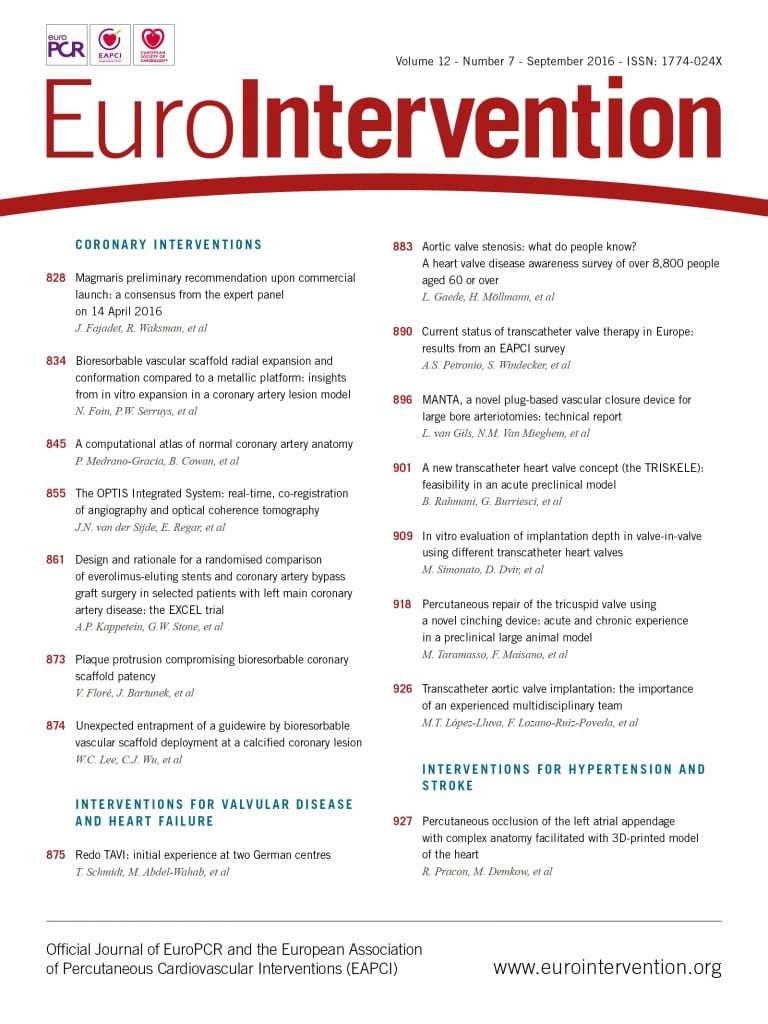
“Valve durability emerges as the most persistent criticism of biological valves. However, we have come to recognize that failure or degeneration in a biologic valve is a slowly progressive process. This means that there is adequate warning and plenty of time for a safe, planned second procedure. The message I am trying to deliver is that we should not be deflected by the mechanical valve proponents into believing that valve durability is the key factor keeping patients alive. The fact that the valve is fine and unmarked, after the patient is dead, is of little interest to anyone but the manufacturers. It is imperative that we remember that valve safety ranks more importantly than durability when related to the clinical scene.”
On the durability of surgical bioprosthetic pericardial valves
Donald Ross 1982
Transcatheter aortic valve implantation (TAVI) is now an established treatment option for patients with symptomatic severe aortic stenosis who are inoperable or present increased or intermediate risk for surgical aortic valve replacement (SAVR)1. An unprecedented evidence base2-8 has allowed rapid expansion of this technology worldwide and meta-analysis of the available randomised clinical trial data indicates similar or even superior clinical outcomes of TAVI compared with SAVR, particularly when performed via transfemoral approach9. Trials in younger, low-risk patients are ongoing and the volume of TAVI procedures now exceeds SAVR in many nations10.
Unbridled enthusiasm for TAVI has been tempered by the lack of knowledge concerning long-term durability. Even though a second minimally invasive, low-risk TAVI procedure (the so-called “TAV in TAV”) is a realistic proposition11, the need for a second interventional procedure is not an attractive prospect for patients. Indeed, this has been an important consideration for cardiac surgeons over many years when choosing between mechanical and bioprosthetic valves, and valve-in-valve TAVI procedures are now commonplace in patients who have outlived their original surgical bioprosthesis.
Five-year echocardiographic follow-up from the pivotal randomised trials has demonstrated excellent long-term haemodynamic function of first-generation TAVI devices12,13. Transvalve gradients are consistently lower with TAVI when compared with surgical bioprostheses (translating into lower rates of patient-prosthesis mismatch) and the gap in terms of paravalvular regurgitation has narrowed considerably with newer-generation TAVI devices7,8. Meanwhile, even longer follow-up data from pioneering centres where TAVI programmes were established at an early stage have generated considerable publicity and discussion, but have yet to be formally reviewed and published.
Joint data from early adopting TAVI centres in Rouen and Vancouver presented by Dvir et al at EuroPCR in May 201614 suggested relatively high rates of structural degeneration of first-generation TAVI devices implanted five to 14 years previously, particularly in subjects with renal failure. Thus, amongst 378 high-risk elderly patients with a median survival time of 51 months (interquartile range 22-75 months), structural valve degeneration (defined as at least moderate aortic regurgitation AND/OR mean gradient >20 mmHg which was not present within 30 days of the index procedure) was present in 35 (9.3%). However, these preliminary unpublished data were criticised on account of methodological considerations, the novel endpoint chosen, the lack of clinical correlations (particularly symptomatic status), and failure to appreciate the hazards of presenting long-term Kaplan-Meier survival analysis based upon such small numbers at follow-up (as eloquently summarised in this edition of EuroIntervention)15. Moreover, senior co-investigators from Rouen and Vancouver have subsequently presented refined independent analyses of the same datasets at TVT in June 2016 using different study endpoints with reassuring outcomes16,17. Thus, amongst 239 patients who underwent TAVI in Rouen between 2002 and 2011, 45 remained alive in 2016 (total follow-up 686 years, maximum follow-up 9.4 years). Structural valve degeneration (defined as mean valve gradient >20 mmHg AND an increase of >10 mmHg compared with echocardiography 30 days post-procedure OR new moderate/severe aortic regurgitation) was present in only four (1.7%) of these patients (two deaths, one reintervention, one asymptomatic)16. Similarly, amongst 266 patients who underwent TAVI in Vancouver between 2005 and 2011, structural valve degeneration assessed by means of systematic echocardiography (and defined as severe aortic stenosis AND/OR severe aortic regurgitation OR need for reintervention) was present in only five surviving patients (1.9%)17.
The rapid expansion of TAVI has been based upon sound clinical evidence derived from randomised controlled trials and large-scale national and international registries. Continued careful surveillance of individual patients and existing research populations remains appropriate, and agreement of a standardised VARC definition of structural valve degeneration is urgently required. Moreover, independent and carefully monitored registries of all commercially available transcatheter and surgical bioprostheses should be established to provide reliable estimates of long-term durability and valve-related clinical events.
To date, there are no robust data to signal that the durability of transcatheter heart valves is a cause for concern. Full-scale expansion into low-risk younger patients remains inappropriate beyond the setting of a randomised trial, but there is no indication to modify current indications for TAVI or the anticipated expansion to intermediate-risk cohorts mandated by recent trial data. In other words – KEEP CALM AND CARRY ON.
Conflict of interest statement
B. Prendergast has received lecture fees from Edwards Lifesciences and Boston Scientific. C. Tamburino has received speaker’s honoraria from multiple companies including Abbott Vascular. N. Piazza is a consultant for Medtronic, MicroPort and HighLife and also has an equity share in HighLife. M. Haude reports receiving study grants and lecture fees from Biotronik, Abbott Vascular, Cardiac Dimensions, Medtronic, Volcano, and Lilly. S. Windecker has received research contracts to the institution from Biotronik and St. Jude.

